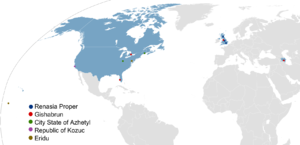Gishabrun SAR
This article refers to a micronation or element of micronationalism which is defunct and no longer exists. You can help make the article reflect that or ask on the talk page for further information. |
Gishabrun | |||||||||||
|---|---|---|---|---|---|---|---|---|---|---|---|
| Anthem: Immortal Victims | |||||||||||
 Gishabruni claims in red. | |||||||||||
| Capital | Kravat Oblast | ||||||||||
| Official languages | English | ||||||||||
| Demonym(s) | Gishabruni | ||||||||||
| Government | Constitutional Monarchy/State Capitalism | ||||||||||
• Knyaz | HEE Kuri I | ||||||||||
| Legislature | Board of Directors | ||||||||||
| Establishment | 22 July 2012 | ||||||||||
| Population | |||||||||||
• 2015 census | 8 | ||||||||||
| Currency | Pecune | ||||||||||
| |||||||||||
This was a Renasian Special Autonomous Region (SAR) | |||||||||||
Gishabrun SAR, officially Gishabrun, was a Special Autonomous Region (SAR) of the Free State of Renasia that bordered Canada, the United States, the United Kingdom, and Azerbaijan. It was the direct successor to the Tsarist Empire of Gishabrun, which was an independent micronation.
Gishabrun was led by Knyaz Kuri I. It was organised in a form of State Capitalism, wherein the state corporation KleinZav ran the SAR and was identical to the region's government. In this way, much of the Tsarist Empire's bureaucratic legislature was done away with and replaced by an oligarchic Board of Directors that dealt with Gishabruni and foreign matters.
On May 5, 2015, following the dissolution of the Gishabruni government on March 17, 2015, Gishabrun legally seceded from Renasia. This occurred as a result of the automatic termination of the Gishabrun SAR Treaty (2012), due to the Free State's official dissolution. Since then, Gishabrun has existed as a non-territorial cultural entity.
Etymology

The name "Gishabrun" is derived from the Vulu-vulu (a defunct constructed language invented by Kuri Kabanov) word "Gishabra", meaning achievement, with the suffix "-un", denoting a place (like "-stan" in Farsi). This was chosen to symbolise the effort required to bring about the establishment of the nation and its intended superiority to other contemporary macrogovernments.
History
On the 22nd of July, 2012, the Tsarist Empire was dissolved and joined the Free State of Renasia as a Special Autonomous Region (SAR). The position of Tsar was abolished and was replaced by the position of Knyaz (equivalent to a Prince). All of the lower houses of the Council of Gishabrun were dissolved as well, and the Elite Duma became the sole legislative house. This situation was intended to be temporary, in preparation for a new Gishabruni government as the new constitution was being drafted.
On the 2nd of June, 2013, the people of Gishabrun could not organise an election in time for the final constitutional deadline, and so the government had to be dissolved. HEE Knyaz Kuri became the absolute ruler. Gishabrun finally adopted a new constitution on 22 July 2013. This constitution made the region officially state capitalist, with the corporation KleinZav being identical to the government. The position of Knyaz became limited by a constitution once again.
The 2013 Toronto Summit was hosted in part in Kravat Oblast on 29 August 2013, which involved a state visit from Barnaby Hands, President of DES Senya.
On 23 June 2014, Gishabrun claimed a homestead near the town of Imishli, Azerbaijan, called Kənd Oblast, making it the first micronational claim bordering Azerbaijan that has micronational citizens residing there. Gishabrun later claimed a household bordering Manchester, UK, formerly the capital of the Technological Federation of Erephisia, as "Erephisia Oblast", on 28 November 2014.
On 17 March 2015, after a prolonged period of internal inactivity, HEE Knyaz Kuri resigned from most of his micronational positions, retaining only the title 'Knyaz of Gishabrun'. He submitted a motion in the Board of Directors to suspend the Gishabruni constitution, which resulted in Gishabrun again becoming an absolute monarchy under HEE Knyaz Kuri. In his first decree, HEE Knyaz Kuri put forward a two stage plan to transition Gishabrun into a state of prolonged inactivity:
- First, the Knyaz defined the Gishabruni monarchy and Royal Court, and announced his intention to not renew the Gishabrun SAR treaty on July 22, 2015.
- Then, once independence was achieved, Gishabrun was to relinquish its land claims and become a "non-territorial cultural entity reflecting an historical legacy".[1]
However, with this announcement from the Knyaz of Gishabrun threatening to further weaken an already deeply inactive Renasia, Meritarch Jacob Tierney announced a referendum on whether to dissolve the Free State. This referendum passed on May 5, 2015, which resulted in the automatic secession of Gishabrun several months ahead of time. Since then, Gishabrun has existed as a non-territorial cultural entity.
Government (2013-2015)

For most of its existence, Gishabrun was a constitutional monarchy, meaning that it was ruled by a monarch (known as the Knyaz) whose powers were restricted by a constitution. As a state capitalist jurisdiction, Gishabrun's government was identical with the executive body of the state corporation KleinZav, and the Knyaz was the head of KleinZav as well as of Gishabrun. As well as the Knyaz, there was also a legislature called The Board of Directors, which made and revised the laws of the nation, decided upon actions within the region, and also acts as the local court. The Board is described as follows in the Gishabruni constitution:
Article 1 - Definition
The Board of Directors is the executive and legislative council that controls KleinZav as well as Gishabrun. It consists of:
1. The Knyaz
2. Director of Gishabruni Affairs
3. Director of Research and Industry
4. Director of Foreign Business
5. Director of Economic Profitability
Article 2 - Duties of the Director of Gishabruni Affairs
The Director of Gishabruni Affairs is responsible for the development of Gishabruni culture, sport, land claims, referenda and popular concerns, oblastian affairs, and national holidays.Article 3 - Duties of the Director of Research and Industry
The Director of Research and Industry is responsible for scientific research and experimentation, production, and exploitation of resources.Article 4 - Duties of the Director of Foreign Business
The Director of Foreign Business is responsible for sales, production, and other operations outside of Gishabrun.Article 5 - Duties of the Director of Economic Profitability
The Director of Economic Profitability is responsible for loaning and storing money, making the budget, obtaining taxes, and managing investments.Article 6 - Duties of the Knyaz in the Board of Directors
The Knyaz as a Director is responsible for all things not already under the authority of the other Directors.— Excerpt of Section 3 of the Gishabruni Constitution
Directors were appointed by the Knyaz.
Members of the Board of Directors
- Director of Gishabruni Affairs: Cyril
- Director of Research and Industry: Richard
- Director of Economic Profitability: Sovetus
- Director of Foreign Business: Billy Neil
- Knyaz of Gishabrun: Kuri Kabanov
Oblasts and Krais
The Tsarist Empire of Gishabrun was divided into administrative divisions for easier governance. All populated subjects were called oblasts, and all uninhabited federal subjects were called krais. The following is a list of the oblasts of Gishabrun as of 2015:
| Flag | Name | Date created | Picture | Ambassador | Population | Description |
|---|---|---|---|---|---|---|

|
Kravat Oblast | May 2010 | 
|
Kuri Kabanov | 4 | The capital and original oblast of Gishabrun, comprising the residence of Knyaz Kuri and his family. It also contained the national aquarium and the KleinZav sumac processing facility. It bordered Ontario, Canada. |

|
Somewhere Oblast | 8 July 2010 | 
|
Sovetus | 3 | This oblast contained the residence of Sovetus and his family. It bordered Ontario, Canada. |

|
Eternal Summer Oblast | 25 August 2010 | N/A | Jason | 1 | This oblast contained the residence of Jason and his family. It bordered Florida, USA. |

|
New Ultramaar Oblast | 17 September 2010 | 
|
Cyril | 1 | This oblast contained the residence of Cyril and his family. It was formerly the capital of the Autonomous Empire of Maccrage, an Autonomous Region of the Tsarist Empire of Gishabrun. It bordered Ontario, Canada. |

|
Kənd Oblast | 23 June 2014 | 
|
Sovetus | 1 | This oblast contained the homestead of Sovetus' relatives. It bordered Imishli region, Azerbaijan, and was likely the first inhabited micronational claim to border Azerbaijan. |

|
Erephisia Oblast | 28 November 2014 | 
|
Billy Neil | 1 | This oblast contained the home and garden of Billy Neil, formerly part of the Technological Federation of Erephisia. |
And the following is the list of krais:
| Name | Date created | Picture | Description |
|---|---|---|---|
| Wild Isle Krai | May 2010 | 
|
Among Gishabrun's very first claims, it consisted of an island in a river. It bordered Ontario, Canada. |
| Ancient Willow Krai | 20 July 2010 | 
|
This krai consisted of an area in a park containing a large willow tree. It was the site of the Bench War. It bordered Ontario, Canada. |
| Outpost Krai | October 26, 2010 | 
|
This krai consisted of a peninsula on a lake, and contained Gishabrun's only port. It bordered Ontario, Canada. |
| Sumac Krai | 8 March 2011 | 
|
This krai consisted of a small area of grassland. It was formerly known as Sumac Department, a part of the Slinky Empyre and the Slinky Republyc. It bordered Ontario, Canada. |
Former Claims
The following are claims previously made by Gishabrun that were abandoned before its dissolution.
| Name | Date created | Date disestablished | Governor | Maximum Population | Description | ||
|---|---|---|---|---|---|---|---|
| Oblasts | |||||||
| Canis Majoris Oblast | October 2011 | December 2013 | Ambassador George |
1 | This oblast contained the residence of George and his family. It bordered Ontario, Canada, and was disestablished due to the inactivity of its citizen. | ||
Economy

As a state capitalist jurisdiction, Gishabrun's economic development was a top priority of the region. Gishabrun's main export was sumac powder, a sour spice widely used in Middle Eastern cuisine, which KleinZav produced in large quantities from sumac gathered on Canadian territory. In addition, the Bank of Gishabrun, now dissolved, was responsible for the production of Gishabruni and Erephisian currency and their sale worldwide.
Gishabrun also had a fairly large agricultural sector, with a variety of produce being grown on its territory, most notably pears and onions. Livestock only existed in Kənd Oblast, namely chickens and cows. Due to a relatively small yield, these were either consumed by the households growing/raising these plants/animals or given to friends and relatives, and so the economic potential of these was not very large. There was also an attempt to grow oyster mushrooms in Kravat Oblast in 2013, which failed due a contamination of the substrate.
Gishabrun, as a Special Autonomous Region of Renasia, used the Pecune as its official currency, although Canadian Dollars, United States Dollars, Pounds Sterling, and Azerbaijani Manat were often unofficially used on its territory. Kravat Oblast contained the majority of the Renasian silver used to give value to the Pecune.
Geography and climate
In the parts of Gishabrun that bordered Canada, the climate is humid continental (according to the Koppen climate classification system), mildly modified by the Lake Effect due to the presence of a river. The oblasts and Ancient Willow Krai were on the edge of a small valley, while Wild Isle Krai was at the bottom of that valley and surrounded by a river, and all other krais were surrounded by or close to their respective rivers. All these administrative divisions were within the Carolinian Ecozone (which is temperate, mostly deciduous forests), but there is a small amount of marshland in what was Wild Isle Krai. Below is the full climate data for Gishabrun's capital, Kravat Oblast:
| Climate data for Kravat Oblast, Gishabrun, Renasia (1981−2010) | |||||||||||||
|---|---|---|---|---|---|---|---|---|---|---|---|---|---|
| Month | Jan | Feb | Mar | Apr | May | Jun | Jul | Aug | Sep | Oct | Nov | Dec | Year |
| Record high °C (°F) | 16.1 (61) |
14.4 (57.9) |
26.7 (80.1) |
32.2 (90) |
34.4 (93.9) |
36.7 (98.1) |
40.6 (105.1) |
38.9 (102) |
37.8 (100) |
30.0 (86) |
23.9 (75) |
19.9 (67.8) |
40.6 (105.1) |
| Average high °C (°F) | −0.7 (30.7) |
0.4 (32.7) |
4.7 (40.5) |
11.5 (52.7) |
18.4 (65.1) |
23.8 (74.8) |
26.6 (79.9) |
25.5 (77.9) |
21.0 (69.8) |
14.0 (57.2) |
7.5 (45.5) |
2.1 (35.8) |
12.9 (55.2) |
| Daily mean °C (°F) | −3.7 (25.3) |
−2.6 (27.3) |
1.4 (34.5) |
7.9 (46.2) |
14.1 (57.4) |
19.4 (66.9) |
22.3 (72.1) |
21.5 (70.7) |
17.2 (63) |
10.7 (51.3) |
4.9 (40.8) |
-0.5 (31.1) |
9.4 (48.9) |
| Average low °C (°F) | −6.7 (19.9) |
−5.6 (21.9) |
−1.9 (28.6) |
4.1 (39.4) |
9.9 (49.8) |
14.9 (58.8) |
18.0 (64.4) |
17.4 (63.3) |
13.4 (56.1) |
7.4 (45.3) |
2.3 (36.1) |
−3.1 (26.4) |
5.9 (42.6) |
| Record low °C (°F) | −32.8 (-27) |
−31.7 (-25.1) |
−26.7 (-16.1) |
−15.0 (5) |
−3.9 (25) |
−2.2 (28) |
3.9 (39) |
4.4 (39.9) |
−2.2 (28) |
−8.9 (16) |
−20.6 (-5.1) |
−30.0 (-22) |
−32.8 (−27) |
| Average Precipitation mm (inches) | 61.5 (2.421) |
55.4 (2.181) |
53.7 (2.114) |
68.0 (2.677) |
82.0 (3.228) |
70.9 (2.791) |
63.9 (2.516) |
81.1 (3.193) |
84.7 (3.335) |
64.4 (2.535) |
84.1 (3.311) |
61.5 (2.421) |
831.1 (32.72) |
| Average Rainfall mm (inches) | 29.1 (1.146) |
29.7 (1.169) |
33.6 (1.323) |
61.1 (2.406) |
82.0 (3.228) |
70.9 (2.791) |
63.9 (2.516) |
81.1 (3.193) |
84.7 (3.335) |
64.3 (2.531) |
75.4 (2.969) |
38.2 (1.504) |
714.0 (28.11) |
| Average Snowfall cm (inches) | 37.2 (14.65) |
27.0 (10.63) |
19.8 (7.8) |
5.0 (1.97) |
0.0 (0) |
0.0 (0) |
0.0 (0) |
0.0 (0) |
0.0 (0) |
0.1 (0.04) |
8.3 (3.27) |
24.1 (9.49) |
121.5 (47.83) |
| Average precipitation days (≥ 0.2 mm) | 15.4 | 11.6 | 12.6 | 12.6 | 12.7 | 11.0 | 10.4 | 10.2 | 11.1 | 11.7 | 13.0 | 13.2 | 145.5 |
| Average rainy days (≥ 0.2 mm) | 5.4 | 4.8 | 7.9 | 11.2 | 12.7 | 11.0 | 10.4 | 10.2 | 11.1 | 11.7 | 10.9 | 7.0 | 114.1 |
| Average snowy days (≥ 0.2 cm) | 12.0 | 8.7 | 6.5 | 2.2 | 0.0 | 0.0 | 0.0 | 0.0 | 0.0 | 0.08 | 3.1 | 8.4 | 40.9 |
| Sunshine hours | 85.9 | 111.3 | 161.0 | 180.0 | 227.7 | 259.6 | 279.6 | 245.6 | 194.4 | 154.3 | 88.9 | 78.1 | 2,066.3 |
| Source: Environment Canada [2] | |||||||||||||
In what was Eternal Summer Oblast, the climate is subtropical (but modified by the nearby Gulf of Mexico with the Lake Effect), meaning it has an average of 21 degrees Celsius in winter, and an average of 28 degrees Celsius in summer, with 1170 mm of precipitation year-round. Eternal Summer Oblast was on a plain flat area, and had many subtropical plants not found anywhere else in Gishabrun.
The area of Kənd Oblast, which bordered Azerbaijan, has a cold semiarid climate.
Culture
See: Tsarist Empire of Gishabrun § Culture
The culture of Gishabrun SAR was much as the same as that of its predecessor, the Tsarist Empire of Gishabrun. A project to create a joint Azehtyl'n-Gishabruni culture, known as the Asi-Gişa culture, was in development between 2013 and 2015, but never materialised.
References
- ↑ 1st 2015 Decree of HEE Knyaz Kuri, ‘CONCERNING THE TRANSITION TO A PRAGMATIC AND LEGITIMATE MONARCHICAL ORDER’
- ↑ "1981 to 2010 Canadian Climate Normals". Environment Canada. 2014-02-13. Climate ID: 6158350. Retrieved February 24, 2014.


